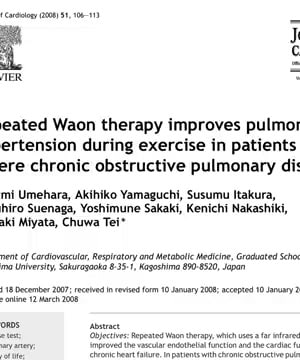What are the benefits of dry saunas? Are they good before bed?
Sources:
Dry saunas offer numerous health benefits, particularly regarding cardiovascular health and stress reduction. Regular sauna use is associated with improved heart rate variability and lower overall stress levels the next day 1. The heat exposure in a sauna acts as a vasodilator, expanding blood vessels and improving blood circulation, which can be beneficial for cardiovascular health 2. Additionally, saunas are known to produce a sense of relaxation and reduced anxiety, potentially leading to better sleep quality 1.
Regarding sleep, using a sauna before bed can indeed be beneficial for some people. Heat exposure helps accelerate the body's cooling process by enhancing blood flow to the extremities, which can drop core body temperature and facilitate the onset of sleep 3. Many people report improved sleep quality after sauna sessions due to this cooling effect and the general relaxation it promotes 4.
However, the timing may need to be personalized. While some find evening sauna sessions greatly enhance their sleep, others might experience better results by using it earlier in the day to avoid potential negative impacts on sleep 5. It's essential to experiment with the timing to determine what works best for you.
RELATED QUESTIONSWhat are other benefits of dry saunas?
Sources:
In addition to relaxation and improved sleep, dry saunas offer several other health benefits:
-
Cardiovascular Health: Regular sauna use has been shown to significantly reduce the risk of cardiovascular diseases and overall mortality 1 2.
-
Improved Lung Function: Sauna therapy can enhance lung function, particularly in individuals with chronic pulmonary diseases like COPD 3.
-
Immune System Support: Frequent sauna use increases white blood cells, lymphocytes, and neutrophil counts, potentially boosting the immune system and reducing the incidence of common colds 3.
-
Heat Shock Proteins: Saunas increase the production of heat shock proteins, which play a critical role in maintaining cellular homeostasis and protecting cells from stress, potentially aiding in longevity 3 4.
-
Mental Health: Sauna sessions can improve mood and reduce symptoms of depression, potentially more effectively than some antidepressants 2.
-
Physical Recovery: Regular sauna sessions can alleviate muscle and joint pain, reduce delayed onset muscle soreness (DOMS), and improve joint flexibility 5.
-
Detoxification: Saunas help with detoxifying the body by promoting sweating, which can help eliminate heavy metals and toxins from the body 6.
-
Exercise Mimetic: The cardiovascular effects of saunas, such as increased heart rate and improved vascular health, make them similar to low-intensity exercise sessions 4 6.
Using a dry sauna can be a valuable addition to a wellness routine, enhancing both physical and mental health. Always ensure to stay hydrated and consult with a healthcare professional, especially if you have underlying health conditions.
RELATED QUESTIONS-
Does it stimulate growth hormone?
Sources:
Yes, dry sauna use can stimulate significant increases in growth hormone levels. A few studies highlight this effect based on the specific conditions of sauna use:
-
Repeated Sauna Sessions:
- Engaging in sauna sessions for 20 minutes at 80°C (176°F) with a cooling period in between can double growth hormone levels.
- 15-minute sessions at 100°C (212°F) can lead to a five-fold increase in growth hormone.
- Intensive routines, like two 1-hour sessions daily at 80°C for a week, can result in a 16-fold increase in growth hormone 1.
-
Combination with Exercise: Combining sauna use with exercise may amplify the growth hormone response even further due to the additional elevation in core body temperature 1 2.
-
Protocols for Maxima:
-
Other Factors: Sauna use in a fasted state or with low blood sugar can further enhance growth hormone release. Timing sauna sessions in the evening, especially a couple of hours after the last meal, can also be beneficial 5 4.
Both and emphasize the importance of careful usage and avoiding excessive heat exposure to prevent any potential harm. Always proceed with caution, ensuring proper hydration and cooling periods.
RELATED QUESTIONS-
What are the benefits to stimulating growth hormone
Sources:
Stimulating growth hormone offers several health benefits:
-
Muscle and Tissue Repair: Growth hormone aids in tissue repair and muscle growth, making it beneficial for recovery from injuries and exercise-induced muscle damage. It promotes the growth of muscle and collagenous tissues, which strengthens tendons and enhances muscle resilience 1 2 3.
-
Fat Loss: Growth hormone influences metabolism, helping to reduce body fat. By enhancing metabolic activity, growth hormone supports fat loss and improvements in body composition 4 5.
-
Increased Collagen Production: Elevated growth hormone levels stimulate collagen production, which improves skin health, reduces wrinkles, and supports the health of joints and connective tissues 1 6.
-
Enhanced Cellular Function and Longevity: Improved growth hormone levels contribute to better overall cell function. This includes positive effects on mitochondrial function, potentially leading to slowing of the aging process and better longevity. Growth hormone can also play a role in improving glandular function, including boosting testosterone production 7 5 8.
-
Bone Health: Growth hormone is crucial for bone growth and maintaining bone density, which helps prevent conditions like osteoporosis. It stimulates the production of collagen, which is an essential component of bone tissue 3.
-
Cognitive and Metabolic Health: Enhancing growth hormone levels can support brain health, cognitive function, and optimal metabolic health. This contributes to a holistic improvement in physical and mental well-being 5 6.
These benefits, while significant, should be balanced with caution due to potential risks of abnormal hormone levels. Always consult a healthcare professional when considering methods to boost growth hormone.
RELATED QUESTIONS-
I don’t have enough time to do the intensive protocol for hours a day. What is a way I can use the sauna to get similar benefits to the long protocol
Sources:
To achieve similar benefits to a long, intensive growth hormone stimulation protocol using sauna, you can follow a time-efficient approach. Here are the key recommendations:
-
Optimal Sauna Routine Once a Week:
- Perform four cycles of 30-minute sauna sessions at temperatures between 187 to 212 degrees Fahrenheit.
- Between each 30-minute sauna session, take a 5-10 minute break for air cooling.
- This routine has been shown in studies to increase growth hormone levels up to 16-fold, which can aid in muscle recovery, fat loss, and overall tissue repair 1 2.
-
Combining Sauna with Fasting or Exercise:
- Exercise can stimulate growth hormone, but combining it with sauna doesn’t necessarily double the effect. Instead, it’s most effective to use the sauna while in a fasted state or at least several hours after eating, as low blood sugar levels also stimulate growth hormone release 3 2.
- Avoid eating 2-3 hours before sauna sessions to maximize growth hormone output 3.
-
Longer but Less Frequent Sauna Use:
- For those with more schedule flexibility, performing 2-hour sauna sessions once a week can produce significant growth hormone increases. This involves shifting between hot and cool environments multiple times within the session 2.
For most people, incorporating sauna use a few times a week, while prioritizing the specific protocol mentioned above, is beneficial without needing to obsess over perfect conditions. Regular sauna use not only boosts growth hormone but also offers metabolic and cardiovascular health benefits 4.
RELATED QUESTIONS-
What's an optimal weekly sauna routine?
Sources:
An optimal weekly sauna routine can offer numerous health benefits, including cardiovascular health and metabolism improvements. Here are some expert-recommended guidelines:
Duration and Frequency
- Frequency: Aim for 4 to 7 times per week for maximal benefits. Using the sauna 4 to 7 times weekly can lower cardiovascular-related mortality by 50% 1.
- Session Duration: Spend 15 to 20 minutes per session in the sauna to reap the benefits. Longer durations can be adjusted based on personal tolerance and goals. For example, two sessions of 15 minutes each, or a single 30-minute session, are both effective 1 2.
- Temperature: Use a traditional sauna at a temperature range of 176°F to 212°F (80°C to 100°C) 3.
Specific Protocols
-
For General Health and Longevity:
-
For Maximizing Growth Hormone:
- Routine: Intense session once a week for 2 hours total, divided into four 30-minute sessions with 5-10-minute breaks in between. This protocol has been shown to increase growth hormone levels significantly 2.
-
For Enhanced Recovery Post-Workout:
- Routine: 15 to 20 minutes of sauna after each workout.
- Benefits: Improved blood flow redistribution, better nutrient delivery, and accelerated shift from sympathetic to parasympathetic state for better recovery 5.
Additional Considerations
- Hydration: It's crucial to stay hydrated and consider using electrolyte supplements to balance mineral loss from sweating 4.
- Consistency: More frequent use can enhance benefits, but even limited use can be beneficial. Start with a manageable routine and adjust as needed based on your response and goals 6.
This routine balances flexibility with effective frequency and duration to fit various lifestyles and goals. Always listen to your body and adjust as necessary.
RELATED QUESTIONSCan you give more expert tips on using saunas?
Sources:
Here are some expert tips for effective sauna use:
Setup and Duration
-
Temperature and Humidity:
-
Session Length:
Frequency
-
Weekly Frequency:
- Using the sauna 4 to 7 times a week has been associated with substantial health benefits, including a 50% reduction in cardiovascular-related mortality 1.
- For those looking to maximize growth hormone levels, an intense session of 2 hours divided into four 30-minute periods once weekly is recommended 4.
-
Post-Workout:
Health Benefits
-
Cardiovascular Health:
-
Cognitive Health:
- Regular sauna use is linked to the prevention of dementia and Alzheimer's due to improved cardiovascular health 7.
-
Hormetic Stress:
Practical Tips
-
Hydration:
- Staying hydrated is crucial, especially if using the sauna frequently. Consider electrolyte supplements for optimal hydration 2.
-
Adaptation:
- Gradually increase your time in the sauna. Start small to allow your body to adapt to the heat stress. Becoming heat-adapted can enhance cardiovascular efficiency, especially post-exercise 2.
-
Combining Elements:
These guidelines can help you optimize your sauna routine for health and performance benefits, while ensuring safety and comfort.
RELATED QUESTIONS-
Do hot tubs have the same benefits
Sources:
Hot tubs offer some benefits similar to saunas, particularly around passive heating and heat exposure, but there are also distinctions.
Similarities
-
Heat Exposure:
- Both hot tubs and saunas provide passive heating, which can aid in post-workout recovery and heat acclimatization 1.
-
Cardiovascular Benefits:
- Regular exposure to heat, whether through a hot tub or a sauna, can have cardiovascular benefits. For example, it helps in lowering blood pressure and improving overall heart health 2.
-
Relaxation and Sleep:
Differences
-
Temperature and Duration:
- Saunas typically operate at higher temperatures (70-90°C) compared to hot tubs (around 40°C). This can lead to different comfort levels and session durations, with hot tubs being used for longer sessions (30-60 minutes) compared to saunas (15-30 minutes) 1.
-
Intensity of Exposure:
- Saunas tend to enforce a more intense heat exposure, leading to the activation of heat shock proteins and potentially providing a stronger hormetic stress response. Hot tubs, being less intense, might allow users to "cheat" by moving their limbs out of the water when it gets too hot 4.
-
Personal Preference and Usability:
- Personal preference plays a role in the choice between hot tubs and saunas. Some people might prefer the immersive nature of hot tubs for relaxation, while others might favor the intensity and cultural aspects of sauna use 4.
Unique Benefits of Saunas
-
Greater Heat Intensity:
- The higher temperatures of saunas can lead to more significant cardiovascular benefits and a stronger immune response, potentially reducing the risk of pneumonia and other infections 4.
-
Metabolic Boost:
- The intense heat in saunas promotes a greater release of heat shock proteins and can aid in improving metabolism and the efficiency of tissue repair, particularly in a Finnish dry sauna setup 3.
Conclusion
Both hot tubs and saunas offer valuable health benefits, particularly around cardiovascular health, relaxation, and sleep improvement. However, saunas may provide more intense benefits due to higher temperatures and a stronger hormetic stress response. Personal preferences and individual comfort levels should guide the choice between the two.
RELATED QUESTIONS-
So hot tubs have the same benefits?
Sources:
Hot tubs and saunas do share some overlapping benefits, primarily related to heat exposure, but there are critical differences, particularly in how effectively they deliver these benefits.
Similar Benefits:
-
Heat Exposure:
-
Cardiovascular Health:
-
Relaxation and Improved Sleep:
- Heat from both hot tubs and saunas can promote relaxation and improve sleep quality, helping users fall asleep more easily and sleep more deeply 3.
Differences in Effectiveness:
-
Heat Intensity and Duration:
-
Biomarker Activation:
- Saunas are more effective at activating certain biomarkers, such as heat shock proteins and sirtuins, because of their higher and sustained temperatures. These biomarkers are important for various health benefits, including longevity and metabolic improvements, which are less robustly activated in hot tubs 5 6.
-
Cheating Tendency:
Expert Insights:
- Dr. Rhonda Patrick emphasizes that while both methods can be beneficial, saunas have stronger evidence for certain health benefits, particularly for cardiovascular health and immune function, due to their higher heat exposure and the inability to "cheat" by cooling off part of your body in a hot tub 3 7.
Conclusion:
While hot tubs do offer some of the same benefits as saunas, especially in terms of relaxation, cardiovascular health, and post-exercise recovery, saunas provide more potent benefits due to their higher temperatures and consistent heat exposure, which more effectively activate key biomarkers and physiological responses.
RELATED QUESTIONS-
Tips for maximizing hot tub benefits?
Sources:
Here are some tips to maximize the benefits of using a hot tub effectively:
1. Optimal Temperature:
- Maintain Ideal Heat: Ensure the temperature is comfortable but effective, generally around 100-104°F (37-40°C). This range is ideal for achieving the relaxation and cardiovascular benefits without risking overheating 1.
2. Duration and Frequency:
- Timing: Use the hot tub for about 15-30 minutes per session. Short sessions are sufficient to gain the benefits while avoiding dehydration or overheating 1.
- Regular Use: Consistency is key. Regular use, such as 3-4 times a week, helps in maintaining ongoing health benefits like improved circulation and relaxation 1.
3. Hydration:
- Stay Hydrated: Drink water before and after using the hot tub to prevent dehydration. The high temperatures can cause significant sweating and fluid loss, so keeping hydrated is crucial 1.
4. Pre and Post-Soak Ritual:
- Pre-soak Cleanse: Rinsing off in a shower before entering the hot tub can help keep the water clean and reduce the load on the hot tub’s filtration system 1.
- Post-soak Cooling: Allow your body to gradually cool down after soaking. This can help to avoid sudden changes in blood pressure and extend the relaxation benefits 1.
5. Filtration and Cleanliness:
- Effective Filtration: Regularly maintain and clean your hot tub’s filtration system. Consider systems that use advanced disinfection methods, such as ozone, which are more effective and have fewer chemical byproducts 1.
- Regular Water Changes: Follow manufacturer guidelines for changing the water. Using clean water ensures better hygiene and improves the overall experience 1.
6. Grounding and Natural Environment:
- Grounding Benefits: Although typically more associated with natural bodies of water, some hot tub setups can incorporate grounding techniques. Using metal tubs and ensuring they are electrically connected to the earth can provide additional circulatory and psychological benefits 1.
These tips, focusing on proper temperature, duration, hydration, maintenance, and incorporating grounding when possible, can help you make the most of your hot tub sessions.
RELATED QUESTIONSIs it okay to use the sauna in the morning
Sources:
Yes, it is generally okay to use the sauna in the morning, but the benefits and impacts can vary depending on your specific goals and circumstances:
General Benefits:
- Cardiovascular Health: Regular sauna use, including in the morning, can enhance cardiovascular health and longevity, especially when done frequently (e.g., 3-7 times per week) 1.
- Mental Health: Morning sauna sessions can also be beneficial for mental health, offering a way to increase endorphins and improve overall mood through the release of dynorphins and subsequent endorphin sensitivity 1.
Specific Considerations:
- Sleep Quality: Using the sauna in the evening may have additional benefits for sleep by promoting a post-sauna cooling effect which helps in reducing core body temperature, making it easier to fall asleep. However, this effect would be diminished if using the sauna in the morning 2.
- Hydration: Morning sauna sessions can help kickstart your day but ensure you stay hydrated. Saunas can lead to significant fluid loss, which might impact your day adversely if not properly managed 3.
Practical Advice:
- Integration with Exercise: For some, combining morning exercise with sauna use can be beneficial. For instance, doing sauna after morning cardio can help with recovery and cardiovascular health. Avoid using saunas immediately post-resistance training as it can interfere with muscle adaptation processes 3.
- Routine Adjustment: Incorporate sauna use based on your daily schedule. If mornings suit you better and you don't experience any negative effects, it can still be a valuable addition to your routine 1.
In conclusion, using the sauna in the morning is acceptable and can provide significant health benefits, particularly for cardiovascular and mental health. However, for sleep-related benefits, evening sessions might be more advantageous.
RELATED QUESTIONS




























